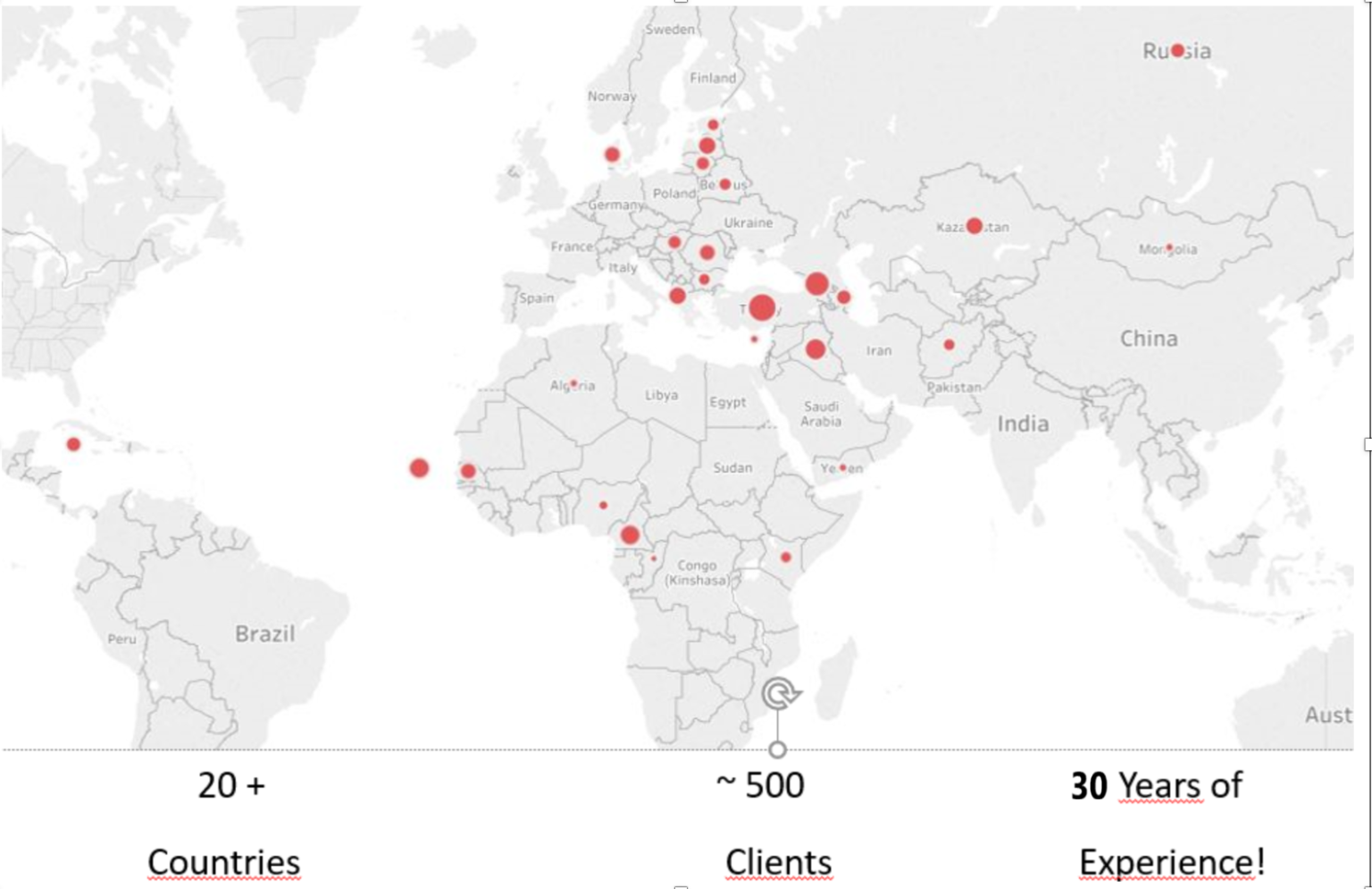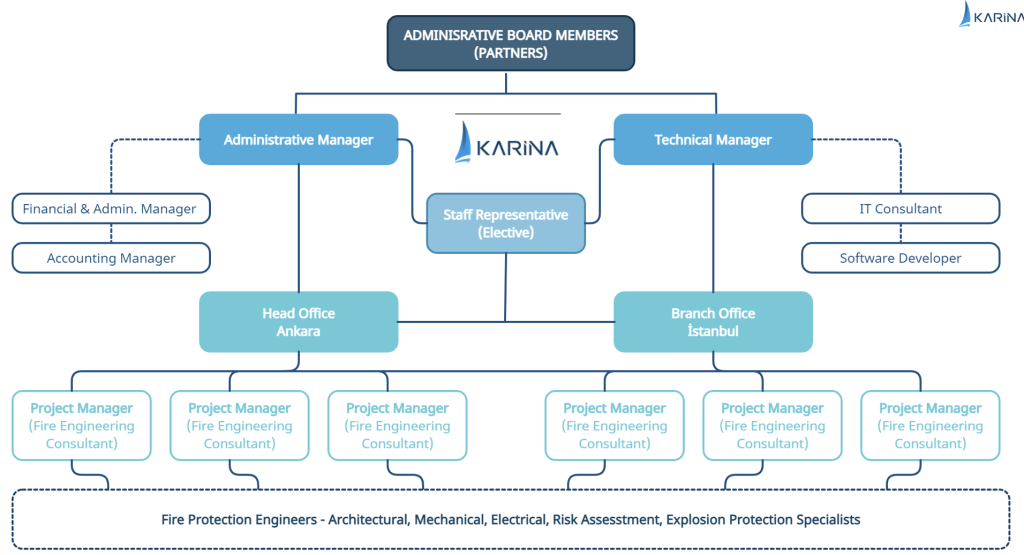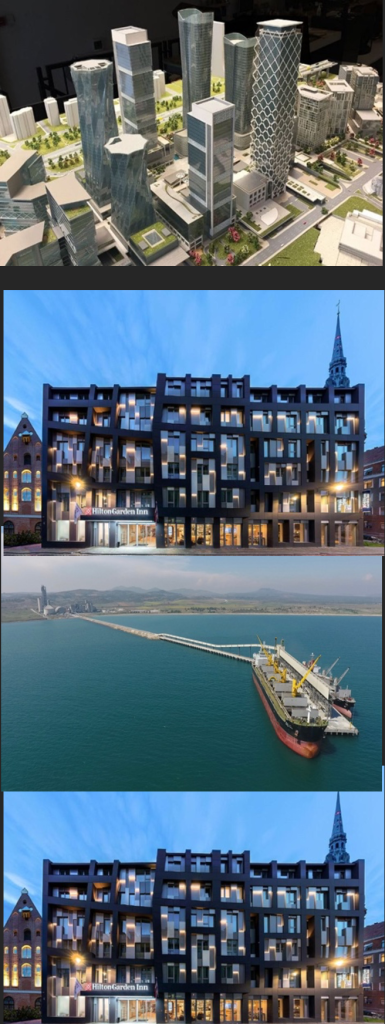
| Şirket Adı | : | KARINA Tasarım, Danışmanlık ve Eğitim Hizmetleri Limited Şirketi |
| Faaliyet Alanı | : | Yangın Güvenliği ve Yangından Korunma |
| Uzmanlık Alanı | : | Yangın Güvenliği ve Yangından Korunma |
| Kuruluş Tarihi | : | 13 Eylül 1994 |
| Vergi Kaydı | : | Ankara Başkent 5240033567 |
| Hukuki/Ticari Sınırlamalar | : | Yok |
| Hukuki Cezalar | : | Yok |
| Mesleki Sorumluluk Sigortası | : | 1 Kasım 1999’dan itibaren geçerli, kapsamı teminatla sınırlıdır (~ 1 Milyon USD) |
| Kilit Personel | : | Ankara’da 8 uzman personel, İstanbul’da 6 uzman personel (Toplam 25 kişi) |
| Telefon | : | +90-312-472 62 88 (pbx) |
| Faks | : | +90-312-478 62 89 |
| E-posta (kurumsal) | : | info@karina.gen.tr |
| URL | : | http://www.karina.gen.tr |
Karina is a global company. Not only local regulations, every country’s standards are based on our fire engineering designs. International standards such as NFPA, BS, IBC are the basis of our approach. Thus we are able to provide service on fire safety all over the world. Here are some of our serviced countries: Georgia, Azerbaijan, Algeria, Uzbekistan, Cyprus, Iraq, England, Cameroon, Bulgaria, Ukraine, Lithuania, Malta, Libya, Serbia, Greece, Albania, United Arab Emirates, Netherlands, Afghanistan, Kosovo, Hungary, Qatar, India, Kenya, Sri Lanka, Kazakhstan, Latvia, Senegal, Russia, Morocc


Total Systems Approach
Developing technology and requirements of the age has separated the fire safety engineering as a different field. Although the elements that establish fire safety are different, multidiscipline should work together with a holistic perspective. Karina provides services in all matters related to fire safety with its integrated working, thanks to its mechanical engineers, electrical engineers and architects.
Our principle is doing the task is only worth value, if only certain business principles and moral values are respected. We are focusing the problem solution as Fire Engineering based, integrated approach for optimising design.
In this respect, Karina is;
Karina is an expert company that sell professional advice to businesses and organizations, to help them solve problems. They do so through their in-house experts and/or external experts.

There are many factors that cause the fire to occur. Identifying these risks has a great importance in terms of preventing the occurrence of fire, extinguishing after the fire occurs, ensuring life safety, preventing or reducing the occurrence of property loss, and protecting business continuity.
Karina uses Risk Management as a tool to achieve cost effective and safe design for studies that is requested by clients. This service includes a wide range of different analysis types and methodologies. It could be a fire risk analysis for all problems and projects, a cost benefit analysis regarding the incorporation of fire protection system for a building, or a comparative study to evaluate different life and fire safety design.
Risk assessment is becoming recognised by the industry and regulation, as the essential method for determining well engineered fire safety requirements. The main aim of assessing fire risk is usually for life safety, however two other areas of risk should also be considered. Property protection and business continuity are equally important specifically regarding damage to buildings causing loss of income due to interrupted service.
Karina’s approach uses a scientifically based risk ranking tool to assess properties. This enables properties to be benchmarked against each other and spending prioritised to achieve the best return on investment. Karina evaluate the potential impact and probability of each risk. Decision makers can then evaluate which mitigation efforts to prioritize within the context of the organization’s strategy, budget, and timelines. Karina can use all risk assessment methodologies and take several approaches to assess risks. Such as;
Quantitative
Quantitative methods bring analytical rigor to the process. Assets and risks receive dollar values. The resulting risk assessment can then be presented in financial terms that executives and board members easily understand. Cost-benefit analyses let decision makers prioritize mitigation options.Quantitative methods can also be quite complex. In addition, some organizations do not have the internal expertise that quantitative risk assessments require.
Qualitative
Where quantitative methods take a scientific approach to risk assessment, qualitative methods take a more journalistic approach. Assessors meet with people throughout the organization. Employees share how, or whether, they would get their jobs done should a system go offline. A qualitative risk assessment provides a general picture of how risks affect an organization’s operations.
Semi-Quantitative
Some organizations will combine the previous methodologies to create semi-quantitative risk assessments. Using this approach, organizations will use a numerical scale, such as 1-10 or 1-100, to assign a numerical risk value. Risk items that score in the lower third are grouped as low risk, the middle third as medium risk, and the higher third as high risk.
Vulnerability / Threat Based
Vulnerability-based methodologies expand the scope of risk assessments beyond an organization’s assets. This process starts with an examination of the known weaknesses and deficiencies within organizational systems or the environments those systems operate within. From there, assessors identify the possible threats that could exploit these vulnerabilities, along with the exploits’ potential consequences.
Threat-based methods can supply a more complete assessment of an organization’s overall risk posture. This approach evaluates the conditions that create risk. An asset audit will be part of the assessment since assets and their controls contribute to these conditions.
Choosing the Right Methodology
None of these methodologies are perfect. Each has strengths and weaknesses. Fortunately, none of them are mutually exclusive. Whether intentionally or by circumstance, organizations often perform risk assessments that combine these approaches.
Design
Measures taken to prevent fire are issues such as passive protection, smoke control systems and establishment of escape opportunities. We inform our employers about the places where protective stairs should be built, the width of the escape routes, the emergency lighting and directioning systems to be installed to decrease the evacuation time and make the escape safe. Separating the building into compartments with fire resistant partitions provides an advantage in preventing fire spread and keeping the fire in a small area. Manual or automatic suppression systems existance prevents the spread of the fire until the fire brigade intervenes. We also provide extinguishing design systems drawings, determination of water tank capacity and other complementary systems, hydraulic calculations, smoke exhaust system calculations.
Complete fire safety can only be achieved through an interdisciplinary system solution. Hence our system design is handled by a design team consisting of architect, civil engineer, mechanical engineer, electrical engineer, chemical engineer, last but not the least human factor analyst. While some of the disciplines are inherent to our company staff, some others are project-basis part-time contributions, depending on the problem, project.
System design service includes system solution, computer aided drafting, computer aided engineering, engineering calculations.
Design services are presented as;


characterise and limit the specific problem. Then specific solutions and applications are designed to meet the specific safety and protection needs of the problem. This type of design is handled both for a specific fire risk itself or for a complementary part or device as well, to improve the overall system performance.
In this respect, Karina is open and willing to cooperate or handle the fire safety solutions of a major project or of a specific fire safety problem, both for a brand new application, as well as an improvement of an existing solution.
Performance Base Design and Solutions
All local regulations and international standards are based on our designs and we both make design with prescriptive approach and performance based. Modeling of fire and smoke spread is a performance-based method used to determine the precautions to be taken. We use Pathfinder, an escape modeling program that will allow us to predict evacuation times, in coordination with Pyrosim and FDS.


Consultancy
We provide design and application consultancy services on fire systems that should be in accordance with regulations in new, existing and historical buildings. But consulting sometimes means going beyond the regulations. For building-specific situations, we determine the appropriate systems and measures with years of experience and knowledge and design team specializing in their discipline in the fire sector.
Technical Consultancy
Commercial Consultancy
Project Management
Training Services
We provide trainings on fire prevention and fire protection to official institutions, companies and individuals. These trainings include fire drills based on fire scenarios determined according to the needs of the trainees and companies.
SERVICES
Karina works on all kind of building occupancy as;



ANKARA |
Çetin Emeç Bulvarı 2. Cad. 37/4 A. Öveçler, ANKARA
İSTANBUL |
Küçükbakkalköy Mah. Defne Sok. Flora Residence No: 1/1512
34746 İstanbul
F |
0312 472 62 88
F |
0216 456 70 04